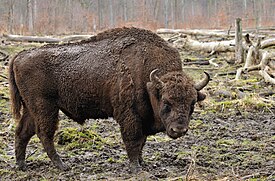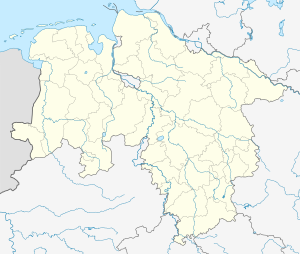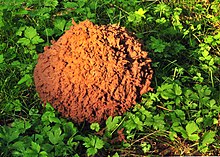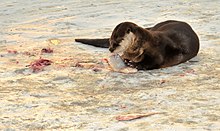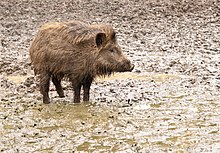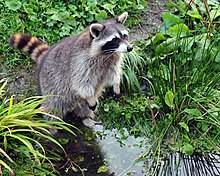Wisent enclosure jump
| Wisent enclosure jump | ||
|---|---|---|
| place | Wisent enclosure 2 31832 Jump |
|
| surface | 90 hectares | |
| opening | 1928 | |
| Animal species | 109 species (August 2013) | |
| organization | ||
| Sponsorship | Lower Saxony state forests | |
| Funding organizations | Friends of the bison enclosure | |
|
The bison enclosure was named after bisons that live close to nature in the enclosure. A bison of the lowland-Caucasus line ( Bison bonasus caucasicus ) from the Springer conservation breed is shown . |
||
|
|
||
Coordinates: 52 ° 11 ′ 19.3 " N , 9 ° 36 ′ 15.9" E


The Wisentgehege Springe is a wildlife park in the south of the Hanover region near the town of Springe in Lower Saxony . 109 species of animals are kept on the 90 hectare site between Eldagsen and Springe in Saupark Springe . It shows animals typical of the region in the natural habitat of the northern low mountain range , the landscape of which is characterized by oak and beech forests, with alder quarries, ponds, meadows and streams. The facility, which resulted from the conservation breeding of bison , was further developed for the conservation breeding of other highly endangered wild species and today, through various facilities such as the falcon yard and wolf enclosure, it is particularly used for environmental education. The bison enclosure is supported by the Lower Saxony State Forests , an institution under public law.
location
The bison enclosure is located in the northeast of the Saupark state forest , which is surrounded by a natural stone wall. The so-called Saupark Wall is a cultural monument. It is located in the LSG-H32 landscape protection area.
Saupark Springe is cut through by the L 461 state road , which leads from Eldagsen to Springe. To the north of the L 461 are the Hallerbruch and the bison enclosure Springe. From the L 461, the district road K 213 leads to Alvesrode . The K 213 separates the bison enclosure from the Hallerbruch, which naturally belong together. The natural area of Saupark Springe essentially comprises the Kleiner Deister and the Nesselberg , on the northern edge of which the enclosure is located. Since 1954 the Kleine Deister and the Nesselberg have formed a nature reserve called Saupark , totaling around 2500 hectares , which includes the Saupark Springe without the bison enclosure.
history

19th century
Former Hutewald
Originally, the forest area of the bison enclosure and the Hallerbruch, cut up by the K 213 district road, was a large hut forest , in which the residents of the surrounding towns used to tend their pigs, horses, goats and cows. This is how the isolated, ancient oaks and beeches that characterize this park landscape were created. It is thanks to the tree veterans that this area is home to a large number of very rare animal and plant species. Certain species of beetles use these old trees and their dead wood as a biotope . One of these beetles, the hermit (also called Juchten beetle), has its largest population here in Lower Saxony. Since the hermit is considered endangered on the Red List , it is under protection along with its habitat. That is the reason that the Haller breaking and Wisentgehege than 212 hectares large Fauna-Flora-Habitat , a part of the European protection system Natura 2000 has become. In addition to other types of primeval forest relics that previously only lived in primeval forests, the Hallerbruch also offers wildcats , four species of woodpecker, bats and various other animal species a unique retreat. In the bison enclosure in 2012, an oak tree that had been populated by hermit beetles was secured with steel ropes to ensure its stability.
Former hunting ground
The establishment of the Saupark Springe is based on a court ruling that sentenced the Hanoverian kings in the 19th century to replace game damage and to reduce the game population. As a result, under King Wilhelm IV. Began to set up an enclosure at the Kleiner Deister. This area had been a royal court hunting ground since the middle of the 17th century. A 16 km long limestone wall was built between 1836 and 1839 as a fence . The building material came from local quarries. The Saupark wall, which also surrounds the bison enclosure on two sides, is a listed building ; it is considered the longest monument in Lower Saxony.
A game population of red deer and wild boar was protected in the enclosure. King Ernst August of Hanover set up his state hunt here in 1837. After the incorporation of the Kingdom of Hanover into Prussia in 1866, the Saupark continued to be a court hunting area, where Kaiser Wilhelm II had royal driven hunts carried out every two years . In 1902 the coronation site was the site of the duel between District Administrator Adolf von Bennigsen and the royal Prussian domain tenant Falkenhagen . Since the Second World War , state hunts have been held there by the Lower Saxony Prime Minister with their state guests and well-deserved personalities from Lower Saxony. The state of Lower Saxony waived state hunts in 2013.
Former duel ground
Adolf von Bennigsen (1860–1902) was a lawyer, landowner and district administrator of the Springe district in Bennigsen . In 1890 he married Elisabeth von Schnehen, who was eleven years his junior, and had five children with her. “ Frivolities ” in the language used at the time led to the fact that he felt compelled to challenge his much younger neighbor, the domain tenant Oswald Falkenhagen , to a duel for insults . The duel on pistols took place on the morning of January 16, 1902 on the "Duelplatz" in the bison enclosure, which had not yet been established. The conditions were: exchanges of fire until incapacity to fight at a distance of 15 leaps . Bennigsen's second was the assessor Ernst Freiherr Langwerth von Simmern ; Falkenhagen was seconded by his brother-in-law. The challenger Adolf von Bennigsen was hit in the abdomen by the challenged Oswald Falkenhagen during the third exchange of fire and collapsed. A quadruple rupture of the bowel by the bullet was later noted. Adolf von Bennigsen was brought to the train station in Springe in a carrying basket and from there by train to Hanover, where he died the next day of complications after the operation - from bleeding in the abdominal cavity - in the hospital of the Henriettenstiftung . He was buried by his family in the park of the estate in Bennigsen. The Reich Chancellor Bernhard von Bülow attended the funeral with the entire Reich government as well as political celebrities from the Province of Hanover .
Adolf von Bennigsen's wife Elisabeth was rejected by the von Bennigsen family as " casus belli ". The “frivolous offender” Oswald Falkenhagen was sentenced to imprisonment for a fortress in February 1902 by criminal chamber I of the Hanover regional court in a jury trial that was widely noticed at the time . The fact that the district administrator's wife was four years older than her admirer and was regarded by the court as the real culprit was taken into account to mitigate the penalty. The dueling pistols, which the district administrator had provided as the claimant, were confiscated in competitive proceedings before the vein court . After this duel, public resistance to this form of satisfaction arose in Germany with the German Anti-Duel League founded in Kassel in 1902 .
20th century
Creation of the bison enclosure
In 1921 the last wild bison in Poland died. In 1922, all bison stocks were extinct in the wild, only 56 pure-blooded bison lived in captivity. In 1923 Polish and German zoologists founded a society to save bison from extinction. The bison enclosure was set up in 1928 under the guidance of the director of the Berlin zoo, Professor Lutz Heck, in the northeast corner of Saupark Springe as a protective enclosure for breeding bison from the lowland-Caucasus line . The aim of the facility was to save the bison, the largest mammal in Europe, from extinction. In 1928 it was not possible to get purebred bison cows in order to establish a bison herd in the bison enclosure. The first attempts at breeding were made with the bison amber from the Berlin Zoo , which was later called Iwan , and with three American bison cows in the form of displacement breeding . An attempt was made to displace the bison inheritance by backcrossing. The displacement breeding succeeded very well, and the hybrids ( bastards ) proved to be very resistant. In 1935, purebred bison cows from the zoo of the Boitzenburg castle complex were bought and the breeding changed accordingly. With the bison bull amber and the purebred bison cows, pure-blood breeding was then possible. The hybrids were given up in 1935.
The establishment of a tuberculosis- free bison population was particularly important . A bull calf and two cow calves were separated from their mothers immediately after birth and raised by hand with replacement milk from the bottle. This special breed, strictly separated from the other bison from 1965 to 1967, formed the new tuberculosis-free basis for today's Springer herd. By 2010, 323 pure-blooded bison had been born, which has contributed significantly to the species' survival to date. To avoid inbreeding, bisons born here are exchanged for bisons from other locations. By 2012, around 140 bison had been given to reintroduction projects , breeding stations and grazing projects .
Expansion to a game reserve
In the 1950s, the conversion of the bison enclosure from an enclosure for bison to a game enclosure for visitors. Friedrich Türcke , head of the Saupark Forestry Office from 1957 to 1978, campaigned vigorously for the bison enclosure. It was thanks to his initiative that the bison enclosure was preserved against all kinds of opposition. The managers of the bison enclosure Joachim Hennig (1972 to 2003) and Thomas Hennig (since 2003) have succeeded in modernizing the bison enclosure and transforming it into an attractive wildlife park.
Art object fighting bison
Fighting bison were the trademark of the bison enclosure Springe. The Wisentgehege Springe has been breeding bison since 1928 . Fighting bison have been luring visitors to the bison enclosure ever since. The 1994 guide through the bison enclosure shows fighting bison on its front page. In order to make this trademark permanently visible, the Lower Saxony State Forests commissioned the artist Gerd Pucka in 1996 to make a sculpture of the fighting bison. For this purpose, Gerd Pucka created a two and a half hundredweight plastic sculpture, the surface of which is bronzed so that it is protected from the elements. In November 1996, the sculpture was attached to the outer wall of the bison enclosure in the presence of the artist and the then head of the bison enclosure, Joachim Hennig. The work of art is at the point where the district road K 213 to Alverode branches off from the state road L 461 to Springe. Next to the sculpture fighting bison is the bronze inscription "Wisentgehege", and a bronze directional arrow shows the driver in which direction the parking lot and the entrance to the bison enclosure are. The artist Gerd Pucka lives in Otze (Burgdorf) . He is a taxidermist and worked at the State Museum in Hanover . He was head of the Burgdorf Hegering and published the taxidermy textbook in 2000 . At the Springe hunting lodge he played a key role in setting up the hunting show.
For the double sculpture of the same name in Kaliningrad , the former Königsberg, see the article Fighting bison .
21st century
Buildings for infrastructure
The entrance area with the night exit is opposite the parking lot. The crossing over the district road K 213 "Zum Saupark" is secured with a pedestrian traffic light. The entrance area is protected against sun and rain by a roof of over 200 m². The environmental educational play station is located there. On the left is the cash building with the enclosure shop, storage and social rooms and visitor toilets. On the right is the office building with the second cash register for busy days.
Outside this visitor entrance there are separate driveways for the company vehicles. The farm buildings for the animal keepers are "behind the scenes". The workshop will be built there in 2015 [obsolete] .
Buildings for keeping animals
The new bird feeder was added to the bear house. A freezer room for fresh meat, a processing room with stainless steel workstations, a defrosting room, a room for breeding feed animals (rats, mice, guinea pigs, rabbits) and a refrigerated defecation room in which meat waste that cannot be fed for the carcass recycling are kept. The freezer room is required for purchased frozen beef and frozen day-old chicks, as well as for frozen game meat waste from the Saupark Forestry Office, which is fed in the bison enclosure. The building is heated with the waste heat from the cooling machine . Workshops for craftsmen and a treatment room for animals were created in the previous feed house. In 2010, feed silos were built in the so-called old bison shed . Maize and grain are stored there for the supply of the wild boar and the water fowl.
The bear bridge at the facility for bears and European wolves was renewed in 2012. In 2014, to the left of the Bear Bridge, the visitor-accessible enclosure for the European wildcats was built . An extension for the Wolverine will be built at the location where their facility was previously , as soon as the funds have been approved. After a moose broke out of the bison enclosure twice, the weak external fences had to be replaced between 2011 and 2013.
Separate enclosures for timber wolves and arctic wolves and numerous night chambers and winter aviaries for the falconry were created for the wolf project. An open small carnivore facility was created; there are three minke , the raccoons , the ferrets (Bonny and Clyde), the polecats and the raccoon dogs . A system for the European mink and an outdoor terrarium for the European pond turtle , the adder and the grass snake are planned .
The small aquarium with terrarium burned down completely and was never rebuilt. The replacement Aquatop has not yet been funded. The word aquatop is derived from the words aquarium and biotope; because the building should achieve a unity of aquarium and biotope. The keeper is thinking of an appealing show on local aquatic ecology à la " Bitterling needs mussels for its eggs".
Buildings for training purposes
In 2010 a training building named after Heinz Sielmann was built, in which the forest education center is located. Like the Café Wild and the cash point of the bison enclosure, it was built using a wooden stand . It contains a large multifunctional room for a whole school class with a separate laboratory area, a sanitary wing, a kitchen and two offices for the teachers as well as storage and technical rooms. The low-energy house cost around € 300,000 and is heated with wood pellets . The technical room is arranged in the building so that the pellet heating system can be viewed from outside through a large window.
Further training structures were erected at various points in the bison enclosure. In the Falkenhof there is a Mongolian yurt that houses the exhibition about the pickling in Central Asia . An information pavilion at the duck pond shows a gray heron nest . A collection of different bird nests can be found in the renovated lookout building called Schöne Aussicht . A panorama window allows a wide view of Sorraia horses and bison of the lowland-Caucasus line . In addition, an insect pavilion was built near the beaver enclosure, which is no longer occupied. There are three educational stations in the extension part of the bison enclosure. A quiz station on the subject of foxes, an information station on rotting waste and one on the subject of roebuck.
Facilities
The bison enclosure fulfills the legal mandate of environmental education for the Lower Saxony State Forests . A visitor survey was carried out in 2001 in order to be able to adapt the educational offer to the visitor profile. According to a similar statistical survey carried out in 2012, of around 152,000 visitors to the bison enclosure, 70 percent were adults and 30 percent were children. Young people between the ages of 14 and 24 were hardly among the visitors. Around a quarter of all visitors attended events, including corporate events and family celebrations. In 2013, a total of 24 employees worked in the bison enclosure including the falcon yard and wolf enclosure in the areas of environmental education and animal husbandry. In 2014 almost 170,000 visitors came to the bison enclosure.
Mammal species are kept in the largest proportion of the total area in terms of area. Other facilities that not only depict animals but also show the relationship between species conservation and habitat are:
Falkenhof
The Falkenhof has been part of the bison enclosure since 2002, run by the falconer Rouven Polep (since 2004) and his team. The facility is located in the middle of the bison enclosure, allows viewing the exhibited birds of prey and owls and visiting the moderated flight demonstrations.
A rescue station in the Falkenhof takes care of injured birds of prey and owls for the bison enclosure and arranges for them to be released into the wild. The Falkenhof participates in breeding programs for endangered bird species and also breeds birds for the Falkenhof and for private falconers. The breeding station for this was built in 2007.
The Falkenhof supports the German Falcon Order . Prospective falconers who want to take the state examination at the Jägerlehrhof in Springe visit the Falkenhof during their course. A cooperation exists between the Falkenhof and the University of Veterinary Medicine Hannover . The influence of flight training on the blood circulation of the catch is examined . It is about new therapeutic options for bumblefoot disease (pododermatitis). Since April 2005 the Falkenhof has supported the photo workshop, which takes place twice a year.
The Falkenhof was founded in 2002 by the married couple Kristin and Wolfgang Krischke, who now run the Princely Riding School in Bückeburg . In May 2004, Rouven Polep was hired by the Krischke family as a professional falconer. After a short time he was responsible for running the Falkenhof. When it became clear in mid-2006 that the Krischke family did not want to continue running the Falkenhof, Rouven Polep started his own business there. He signed the contracts as a subcontractor with the Lower Saxony State Forests and became owner of the falconry at the end of 2006. He increased the population of birds of prey from 20 to around 70 day and night raptors, many of them from his own breeding, built the breeding system and built night chambers and winter aviaries. The animals are shown partly in aviaries and partly in flying wire systems. In these systems the bird can move freely and change its sitting position according to its own needs. At the flywire systems, visitors can get close to the birds of prey and look at them with an unobstructed view. 17 new aviaries were completed in 2012. In this way, all of the old systems erected as a temporary measure in 2002 were replaced.
Wolf project
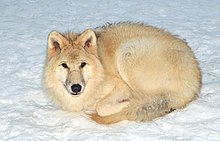
In 2010 the wolf enclosure for the hand-reared timber wolves was built in a size of 2000 m². It is surrounded by a two-and-a-half meter high double bar fence, under which reinforcement meshes are inserted to a depth of one and a half meters so that the wolves cannot dig through under the fence. In 2013, a second large wolf enclosure was built for the hand-reared polar wolves. Until then, the arctic wolves lived with the timber wolves. There is also a small enclosure for sick wolves.
Matthias Vogelsang and his wife Birgit Vogelsang have been working as a freelancer with four timber wolves since May 2010 and since August 2012 with five arctic wolves in the bison enclosure. He and his wife reared the wolves by hand at home and, as the highest ranking man, leads the pack permanently in the bison enclosure. This offers visitors the unique opportunity to experience wolves up close. Matthias Vogelsang reports in his regular presentations about the animals, their development and about his coexistence with the wolves. The offers also include open wolf evenings with hundreds of guests and private wolf evenings in smaller groups, manager seminars, the photo lesson and a walk in the forest with a wolf. Seven TV reports were broadcast by ZDF, RTL, NDR and KIKA until 2012.
The project is independent of the wolf attitude that has existed for many years with the pack of Eurasian wolves that share its enclosure with the bears.
Forest Education Center
In the bison enclosure, to the right of the petting meadow, is the Heinz Sielmann house, where the forest education center Wisentgehege carries out its work for the Hanover region . The windows direct the view of bison and wild boar. In cooperation with the Heinrich-Göbel-Realschule Springe, various biotopes have been created on the property in which small wild animals find their habitats.
The Forest Education Center Wisentgehege has been a thematic extension of the former Gehegeschule since January 1st, 2010 . Schoolchildren should not only learn about animal enclosure education, but also explore the forest habitat. Over 3,600 people, mostly children, received environmental pedagogical care in the forest pedagogy center in 2012. Cornelia Trippke , educational director of the Gehegeschule in the Wisentgehege, has a colleague who is responsible for the forest area: Hans-Jürgen Thies from the Fuhrberg Forestry Office.
The team at the Forest Education Center Wisentgehege offers school classes and groups of children who visit the wisent enclosure as part of a class trip or children's leisure time a rich program. The age-appropriate educational offer is thematically broad and ranges from animal workshops, days of action, discovery tours to holiday pass campaigns and children's birthday parties.
The forest pedagogy center also offers target group-specific offers for school classes, children and youth groups in forests in the Hanover region and in the Hildesheim area beyond the borders of the Springe location . The educational offer ranges from forest adventure tours, forest action days to special school projects. Family events and children's birthdays are designed for private individuals.
The Forest Pedagogy Center is also an information and advice center for teachers and provides them with zoo pedagogical materials and handouts that facilitate the preparation and implementation of the visit to the bison enclosure. In addition, multiplier training courses and seminars for teaching staff are also offered.
Educational mushroom forest
Since October 1999 there has been a mushroom educational forest in the bison enclosure, through which an educational trail runs. The educational trail provides information about mushrooms that grow in forests on the ground, on trees and on dead wood.
In addition to old oaks and beeches from the former Hutewald forest, there are additional tree species in the teaching forest . Small biotopes favor the settlement of native mushroom species. During the year the interactions between fungi and other plant species can be observed. The decomposition processes of wood-decomposing fungi on old wood and throwing wood and the staggered occurrence of different types of fungi in the same location can be followed over the years .
Illustrated signs at the locations of the mushrooms, an apiary (2013 without bees) and a shelter with information boards provide additional information.
The “mushroom group” of the friends' association has been organizing a mushroom exhibition every year at the Hubertus Festival since 2000.
Aviaries
Aviaries protect the birds living here from raccoons and birds of prey. The large bird aviary is a wood / wire structure that not only houses water birds and large birds but also the Aesculapian snake . The large birds include pairs of the blue peacock , crane , black stork and white stork and the waterfowl also includes pairs of the shelduck and the rust goose . The facility is located near the visitor entrance. There are also bird aviaries in the northeast of the bison enclosure for pairs of golden eagles and eagle owls . In the Falkenhof there are aviaries for the birds of prey , the falcon-like and the owls .
Conservation breeding

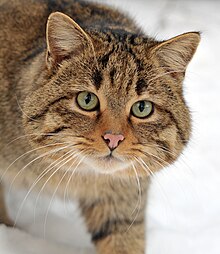
Another essential task of the bison enclosure is to ensure the survival of endangered animal populations through conservation breeding and by giving suitable animals to resettlement projects. Besides the bison, these animal species also include the Przewalski horse , the Mesopotamian fallow deer , the Sorraia horse (until 2009), the wolverine , the eagle owl and the wild cat .
The bison enclosure has so far participated in the conservation breeding program with the delivery of Przewalski horses. The resettlement project in Mongolia is currently home to 320 Przewalski horses. Horses from the bison enclosure were also released into the wild in Mongolia. In 2012 and 2013, a mare born in the bison enclosure was flown from Prague to Mongolia in Czech military aircraft together with three other Przewalski horses. The bison enclosure would like to finance the transport of another Przewalski horse to China or Mongolia from donations. It costs $ 30,000 to fly a horse to Mongolia.
The bison enclosure plays a major role in saving the eagle owl , which has since rebuilt stable populations in Germany. About 300 young birds, some of them from our own breeding, have been prepared here for a life in freedom and then released into the wild. From 1997 to 2012 the bison enclosure participated in the conservation breeding of the European mink .
The bison enclosure serves as the official sanctuary for birds of prey and owls. Seven aviaries stand ready in the background to help weakened, injured or orphaned birds of prey and owls. The goal is to release them. If this is not possible, the animals will be passed on to zoological institutions. The bison enclosure is also a training center for animal keepers.
Breeding of the bison
In 2014, according to the breeding book , the world population of pure-blooded bison was around 5200 individuals, of which around two thirds live in the wild or in large reserves. The goal is a worldwide population of 10,000 bison. Inbreeding should be low and genetic diversity should be kept as high as possible. Bluetongue is a particular threat to European bison, of which around 50 bison fell victim in Germany in 2007. All bison are in the world bison herd book , which in the Bialowieza National Park , registered is performed. The names of the bison from the lowland-Caucasus line from the Springer breed start with the letters Sp for jump . The names of the bisons of the lowland Bialowieża line born in Springe begin with De for Deister . The name alone makes it clear from which breed the bison come and which breeding line they belong to.

The animal populations in the bison enclosure are recorded in the international Species 360 database . The important information about all the animals in the bison enclosure is stored here and is accessible to the other zoos. This means that the bison enclosure is networked with animal parks around the world that animals need for their breeding. There is a lively exchange between the animals and other breeding sites, which prevents the degeneration of the population. Since 1995 there has been a European conservation breeding program for bison, which also includes breeding in the bison enclosure Springe.
Since March 25, 2010, the Wisentgehege Springe has been one of four regional centers in the European Bison Conservation Center (EBCC) to support bison breeding in Germany. As the northern regional center , the bison enclosure is responsible for Lower Saxony, Schleswig-Holstein, Hamburg and Bremen. The bison enclosure Springe sets standards in bison breeding and Thomas Hennig wrote in 2012:
“We play a pioneering role in the knowledge of the genetics of our animals, in knowing all the individual bison in the population and in the permanent, lifelong marking of the bison. The full genetic record of all German bison, which is planned for the next three years, goes back to our commitment in terms of the idea and the immediate financial implementation. "
The European bison population consisted of two subspecies: on the one hand the mountain bison ( Bison bonasus caucasicus ) and on the other hand the lowland bison ( Bison bonasus bonasus ). The mountain wisent became extinct and only exists today as a hybrid form with the lowland wisent . All descendants of the bison bull Caucasus , the last pure-blooded representative of the mountain bison at the time (Stud Book No. 100: Caucasus ), belong to the lowland-Caucasus line (LC); they are subarthybrids . All bisons that do not go back to the bison bull Caucasus belong to the lowland Bialowieża line and are therefore purely preserved bison of the subspecies lowland bison ( Bison bonasus bonasus ). For genetic reasons, the two lines are grown completely isolated from one another.


In bison breeding, a distinction is therefore made between two breeding lines: the pure-blooded lowland Bialowieża line ( Bison bonasus bonasus ) and the lowland Caucasus line ( Bison bonasus caucasicus ), which arose from a cross between the lowland bison and the mountain wisent . In 2009 there were around 1500 bison of the lowland Bialowieża line and around 2500 bison of the lowland Caucasus line (LC).
Since 1928 only bison from the lowland-Caucasus line have been kept and bred in the bison enclosure. In 2011 there were twelve males and 13 females of the lowland-Caucasus line here. Since July 3, 2012 bisons of the rare lowland Bialowieża line have been kept and bred here. The bull Pawik comes from the Białowieża National Park . The bison cows Durana and Dusty came from the Duisburg Zoo and three other bison cows Usara , Usanja and Uslania from Usedom . In addition to the Springe bison enclosure , there is also the Hardehausen bison enclosure in Germany, which breeds both bison of the lowland-Caucasus line and bison of the lowland-Bialowieża line.
The bison enclosure has a total of 36 bison in 4 herds. The lowland-Caucasus line includes the breeding group at the Forest Pedagogy Center (WPZ) , the youth group behind the red deer on the left in front of the Saupark wall and the bull group at the Schöne Aussicht . The fourth separate bison group between the path behind the moose enclosure and the path in front of the beautiful view belongs to the Flachland-Bialowieża line (as of January 2015).
Breeding the Sorraia
Sorraias are said to represent a formerly feral horse breed from the area of the Sorraia River in Portugal. The Portuguese zoologist and hippologist Ruy d'Andrade founded the breeding of the Sorraia horse breed after he found a herd of wild horses near the river Sorraia , which gives it its name . Ruy d'Andrade thought these horses were ancestors of the Andalusians and Lusitanos , which has been proven by some genetic studies, but has been refuted by others.
In 1937 he started a conservation breeding program with a stock of three stallions and seven mares, one of which was in foal to an unknown stallion. In 1948, a gray, heavily zebrated Criollo imported from Argentina was added as the last foreign blood . The continued existence of the breed is considered to be seriously endangered by the small number, the dispersed populations, the close relationship and the resulting lack of vitality and the recent exports of breeding animals to America for the further breeding of Spanish Mustangs. The Portuguese Horse Breeding Association looks after the Sorraias like a horse breed and not in the sense of their discoverer and sustaining Ruy d'Andrade. The survival of the Sorraia, of which, according to Hennig, there are only around 150 animals left worldwide in 2013, is seriously endangered.
In the current zoological doctrine in Germany, Sorraia horses are not wild horses, but feral domestic horses. That is the reason why Sorraia horses in Germany are only kept in the bison enclosure Springe and not in any other zoological gardens or game enclosures. Contrary to current zoological doctrine, the wisent enclosure, according to Gerhard Freutel and Ruy d'Andrade, assumes that the Sorraia horses are South Iberian wild horses that have apparently survived pure-blooded in the river Sorraia in the south of the Iberian Peninsula. They were the ancestors of the American Sulfur , who were taken by Christopher Columbus on the ships to America and released in America before returning to Europe. Gerhard Freutel from the Friends' Association wrote in May 2012: “Since 1997 there has been a herd of up to 15 animals in the Wisentgehege Springe. The first horses were bought in Portugal and financed by the association. The herd has developed well in breeding despite difficult conditions. The formal cooperation with the stud book, which is kept in Lisbon, is very difficult and the main reason why there is currently no breeding in the bison enclosure. Up to our temporary breeding stop in 2009, 23 foals were born in Springe. ”In June 2013 the Sorraia mare Elvira had a foal for the first time. At that time, the herd consisted of 13 horses, and two mares were used for breeding.
The Sorraia horses were originally kept in the bison enclosure in the forest area that lies between the path behind the elk enclosure and the path in front of the Schöne Aussicht and is now used for breeding the bison from the lowland line. The Sorraia herd has been on the large eastern pasture at Schönen Aussicht since autumn 2011 . The number of black flies is lower on the sunny pasture than in the previously predominantly wooded location of the herd. The Sorraia horses are allergic to black flies and then get sweet itch .
Livestock
The animal population of the Wisentgehege Springe currently comprises 111 species, which are listed in the following overview.
Mammals
|



Birds
|
Reptiles
A makeshift terrarium for the Aesculapian snake is located in the large bird aviary.
insects
- Among other things, the hermit
Regular events
Demonstrations and workshops
Various events are held to make the zoo attractive to visitors and to bring environmental education to life. The regular events outside of winter include flight demonstrations in a bird of prey show with different birds of prey in the falconry in the bison enclosure , presentations of the arctic wolves and timber wolves and show feeding of various animal species such as otters, wolves and bears.
Annually recurring attractions are: the Easter fun for children of Bock beer tapping , the Walpurgisnacht for children, animal Märchenfestspiele , the Midsummer Night Festival , the Children's Festival , the Deer week with the tours to rutting of the red deer , the Pumpkin Festival , the Wolf evenings and Hubertus hard with the Hubertusmesse (as : 2014).
Wildlife photography workshops lasting several days take place in the falcon yard and bison enclosure. Budding wildlife photographers get the opportunity to photograph some animal species in the bison enclosure under expert guidance. Theory and practice are taught, and there is also the opportunity to photograph flying birds of prey.
Additional offers for children are the barefoot path , the handcart, the forest education center, the barbecue hut for children's birthdays, the wooden sound device, the fairy tale forest, the low ropes course , the olfactory organ, the petting enclosure, the humming stone and various playgrounds.
Guided tours and work assignments by the development association
The association was founded on July 16, 1992. It is non-profit and has the statutory task of promoting the bison enclosure. This is done through the voluntary active help of the members in very different areas and through financial support of the bison enclosure with the membership fee of the sponsoring association, which also enables free year-round visits to the bison enclosure and the museum in the hunting lodge. Association members help the bison enclosure with the implementation of events and through work to improve the bison enclosure. Club members have the opportunity to take part in certain events and exclusive guided tours and on a teaching and information trip that takes place once a year on a weekend. In 2013, the association had over 1150 members.
The club hut at the Köhlerhütte is manned by club members on weekends and public holidays from April to October, who sell postcards and badges and are available for discussions with interested visitors. On Sundays from April to October, club members offer free local accompaniment in the bison enclosure at 10 a.m. at the entrance to the wisent enclosure.
Memberships of the bison enclosure
- DWV (German Game Reserve Association) . The Falkenhof has also been a member since 2013.
- European Conservation Breeding Program (EEP) Participation in the European Conservation Breeding Program for: Przewalski's horse, black stork, wolverine, European mink, wisent, Mesopotamian fallow deer. (As of February 15, 2010)
- Species 360 , formerly ISIS (International Species Information System)
Collaboration in the European Bison Conservation Center (EBCC)
- The Wisentgehege Springe has taken over the function of the EBCC regional office Northern Germany in the European Bison Conservation Center (EBCC). A three-year project for the genetic registration of all 600 bison in Germany is running under his direction.
Research projects
The main research areas of the University of Osnabrück in the Wisentgehege Springe are:
- Draft of a bison ethogram based on film analyzes
- Is there a sexual segregation in the case of bison keeping?
The Neuvrees reintroduction project was carried out in 2005 . In further research, the TiHo Hannover examined wild horses for infestation by endoparasites , and the University of Göttingen made a contribution to the development of the red deer in the youth stage.
In 2013, the Leibniz University of Hanover started a research project to examine the biotope of the listed exterior wall belonging to the nature reserve.
Awards
- September 2009: Award of the European Bison Friends Society (EBFS) for the long and successful bison breeding in the bison enclosure Springe.
- October 2013: At the congress of the European Bison Friends Society (EBFS) in Czarna , Poland , the head of the Lower Saxony Forestry Office Saupark Joachim Menzel was honored for his many years of service to bison research.
See also
literature
- Hugo Friedländer : Interesting criminal trials of cultural and historical importance. 12 volumes, Berlin 1911–1921. P. 204 ff. At Zeno.org
- Friedrich Türcke : The bison enclosure in the Saupark nature reserve near Springe . JC Erhardt, Springe, approx. 1960.
- The bison enclosure. Wisentgehege Springe, Springe 1966, like 1968.
- Friedrich Türcke: Conservation and breeding of the bison in Germany . In: German veterinary weekly . 87th year (1980), pp. 416-419.
- Ernst Andreas Friedrich : Designed natural monuments of Lower Saxony . Landbuch-Verlag, Hannover 1982, ISBN 3-7842-0256-X .
- Wisentgehege Springe: The bison enclosure. Jump 1994.
- Lower Saxony Forest Office Saupark: The bison enclosure of the Lower Saxony Forest Office Saupark. A center of conservation and species protection in Lower Saxony with a 70-year tradition. Examples of species protection through conservation breeding in the bison enclosure. A companion for interested visitors. Jump 1998.
- Michael Kings: Investigations on endoparasite infestation in wild equidae taking into account the pasture infestation in the Serengeti-Park Hodenhagen and in the bison enclosure Springe. Hanover, University of Veterinary Medicine 1999. Dissertation 1999.
- Wisentgehege Springe: Wisentgehege in Saupark Springe. Educational mushroom forest . Jump 2001.
- Gerhard and Herbert Müsch: Animal portraits from the bison enclosure . Verlag M. Faste, Kassel 2006, ISBN 978-3-931691-45-5 .
- Wisentgehege Jump: game guide . Springe undated (2010/2011).
Web links
- Homepage of the bison enclosure
- Homepage of the Falkenhof in the bison enclosure
- Forest Education Center Wisentgehege (PDF; 949 kB)
- Thomas Hennig: Annual Chronicle 2012 . (PDF; 1.6 MB) Wisentgehege Jumpe
- Wisent reports of the association (with PDF)
- Complete overview of the guides through the bison enclosure at leszoosdanslemonde.com
Individual evidence
- ↑ Website of the Lower Saxony State Forests ( Memento of the original from October 14, 2013 in the Internet Archive ) Info: The archive link was inserted automatically and has not yet been checked. Please check the original and archive link according to the instructions and then remove this notice. .
- ^ Lower Saxony: Marking of historical buildings in the Saupark Forestry Office
- ↑ Regulation text on the "Saupark" nature reserve in the database of the Lower Saxony State Office for Water Management, Coastal and Nature Conservation (NLWKN)
- ↑ Source: Wisentgehege Springe: Wildführer page 52.
- ↑ jaegerlehrhof.de
- ↑ Meyer abolishes the state hunt ( Memento from August 12, 2013 in the Internet Archive )
- ↑ Herbert Kater: The duel between the district administrator Adolf von Bennigsen and the domain tenant Oswald Falkenhagen in Saupark / Springe 1902. In: Einst und Jetzt Volume 37 (1992), page 222.
- ↑ Herbert Kater: The duel between the district administrator Adolf von Bennigsen and the domain tenant Oswald Falkenhagen in Saupark / Springe 1902. In: Einst und Jetzt Volume 37 (1992), page 218.
- ↑ Herbert Tomiczek: On the death of Dr. Friedrich Türcke . In: Journal for Hunting Science . 45th year. No. 1/1999, p. 73
- ↑ Complete overview of the guides through the bison enclosure at leszoosdanslemonde.com
- ^ Article Wall adorned with sculpture in the Neue Deister Zeitung of November 16, 1996.
- ↑ Brigitte Kieth: The bison enclosure is becoming a forest education center. In: Leine-Nachrichten ( Hannoversche Allgemeine. ) January 4, 2010, p. 9.
- ↑ Lower Saxony State Parliament - 15th electoral period, printed matter 15/2524, Annex 1
- ↑ Lower Saxony State Parliament - 15th electoral period, printed matter 15/2524, Annex 1, page 9
- ↑ Interview with Thomas Hennig. In: Leine-Nachrichten der HAZ , March 15, 2013, p. 9.
- ↑ Thomas Hennig in the 2014 annual report from January 2015.
- ↑ Matthias Vogelsang presents himself on his homepage. ( Memento from February 11, 2013 in the Internet Archive )
- ↑ Opening of the Heinz Sielmann House in the Wisentgehege Springe ( Memento from June 22, 2011 in the Internet Archive )
- ↑ Flyer Forest Education Center Wisentgehege. Our educational offers (published in 2012). ( Memento of the original from October 23, 2015 in the Internet Archive ) Info: The archive link was inserted automatically and has not yet been checked. Please check the original and archive link according to the instructions and then remove this notice. (PDF; 949 kB)
- ↑ Source: Information der Landesforsten ( Memento of the original from March 9, 2012 in the Internet Archive ) Info: The archive link was inserted automatically and has not yet been checked. Please check the original and archive link according to the instructions and then remove this notice. and educational offers in the Hanover region and the Hildesheim area ( Memento of the original from June 22, 2015 in the Internet Archive ) Info: The archive link has been inserted automatically and has not yet been checked. Please check the original and archive link according to the instructions and then remove this notice.
- ↑ Wisentgehege Springe: Wisentgehege in Saupark Springe. Educational mushroom forest. Jump 2001, p. 2.
- ↑ Hubert Klimke: Two days of permanent storage of the mushroom hut in the bison enclosure. Der Tintling 99, issue 2/2016, pp. 22–24.
- ↑ maintenance breeding. ( Memento from October 6, 2011 in the Internet Archive ) On: wisentgehege-springe.de
- ↑ This list gives an overview of the European locations of the bison in 2011 . (PDF; 211 kB)
- ↑ Source: Wisentgehege Springe: Wildführer page 6–7.
- ^ The European Bison Conservation Center (EBCC). and EBBC - regional centers for Germany.
- ↑ wisentprojekt.de
- ^ Wisent-Report, November 2012, p. 2.
- ^ Bison transport to Springe. and gallery ( memento from April 12, 2013 in the web archive archive.today ).
- ^ Bison enclosure in Hardehausen.
- ^ Genetic diversity and relationships of Portuguese and other horse breeds based on protein and microsatellite loci variation
- ↑ C. Luis, R. Juras, MM Oom, EG Cothran: Genetic diversity and relationships of Portuguese and other horse breeds based on protein and microsatellite loci variation . In: Animal Genetics , 38 (1), February 2007, pp. 20-27, PMID 17257184 .
- Jump up ↑ LJ Royo, I. Álvarez, A. Beja-Pereira, A. Molina, I. Fernández, J. Jordana, E. Gómez, JP Gutiérrez, F. Goyache: The Origins of Iberian Horses Assessed via Mitochondrial DNA . In: Journal of Heredity , 2005, 96 (6), pp. 663-669; doi: 10.1093 / jhered / esi116 .
- ↑ American Sulfur Horse Association and Colonial Spanish Horse # Modern breeds and types
- ↑ Gerhard Freutel: The Sorraia horse introduces itself. In: Wisent-Report of the Förderverein Wisentgehege Springe, Springe, May 2012, p. 7.
- ↑ Hannoversche Allgemeine Zeitung , June 15, 2013, p. 17.
- ↑ Current inventory . Website Zootierliste.de.
- ^ The sponsoring association Wisentgehege Springe.
- ↑ Source ( Memento of the original dated December 7, 2014 in the Internet Archive ) Info: The archive link has been inserted automatically and has not yet been checked. Please check the original and archive link according to the instructions and then remove this notice.
- ↑ The European Bison Conservation Center (EBCC) and the four EBCC regional offices in Northern Germany.
- ^ Rüdiger Schröpfer: Social structure of the wild cattle of the genus Bison ( Memento from May 1, 2013 in the Internet Archive ).
- ↑ Lower Saxony State Parliament - 15th electoral period, printed matter 15/2524, Annex 1, page 7
- ^ Lower Saxony: mapping on the Saupark wall
- ^ The European Bison Friends Society (EBFS). ( Memento of the original from October 23, 2014 in the Internet Archive ) Info: The archive link was automatically inserted and not yet checked. Please check the original and archive link according to the instructions and then remove this notice.
- ↑ Award for services to bison research. Joachim Menzel is honored at an international congress. ( Memento of the original from October 23, 2015 in the Internet Archive ) Info: The archive link was inserted automatically and has not yet been checked. Please check the original and archive link according to the instructions and then remove this notice.
